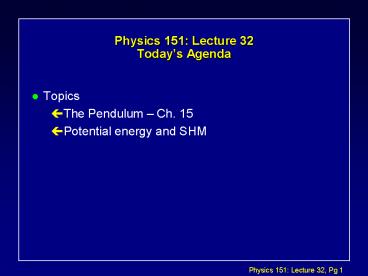Physics 151: Lecture 32 Today PowerPoint PPT Presentation
Title: Physics 151: Lecture 32 Today
1
Physics 151 Lecture 32 Todays Agenda
- Topics
- The Pendulum Ch. 15
- Potential energy and SHM
2
Simple Harmonic MotionReview
See text 15.1 to 15.3
- The most general solution is x Acos(?t ?)
- where A amplitude
- ? frequency
- ? phase constant
- For a mass on a spring
- The frequency does not depend on the amplitude
!!! - The oscillation occurs around the equilibrium
point where the force is zero! - Energy is a constant, it transfers between
potential and kinetic.
3
Lecture 32, Act 1Simple Harmonic Motion
- You have landed your spaceship on the moon and
want to determine the acceleration due to gravity
using a simple pendulum of length 1.0 m. If he
period of the pendulum is 5.0 s what is the
value of g on the moon ? - a) 1.3 m/s2.
- b) 1.6 m/s2.
- c) 0.80 m/s2.
- d) 0.63 m/s2.
- e) 2.4 m/s2.
4
General Physical Pendulum
See text 15.5
- Suppose we have some arbitrarily shaped solid of
mass M hung on a fixed axis, that we know where
the CM is located and what the moment of inertia
I about the axis is. - The torque about the rotation (z) axis for small
? is (sin ? ? )
? -Mgd -MgR??
z-axis
R
?
x
CM
d
Mg
5
Lecture 32, Act 2Physical Pendulum
- A pendulum is made by hanging a thin hoola-hoop
of diameter D on a small nail. - What is the angular frequency of oscillation of
the hoop for small displacements ? (ICM mR2 for
a hoop)
pivot (nail)
(a) (b) (c)
D
6
Lecture 32, Act 2 Solution
- The angular frequency of oscillation of the hoop
for small displacements will be given by
Use parallel axis theorem I Icm mR2
mR2 mR2 2mR2
pivot (nail)
cm x
R
m
7
Torsion Pendulum
See text 15.5
- Consider an object suspended by a wire attached
at its CM. The wire defines the rotation axis,
and the moment of inertia I about this axis is
known. - The wire acts like a rotational spring.
- When the object is rotated, the wire is twisted.
This produces a torque that opposes the rotation. - In analogy with a spring, the torque produced is
proportional to the displacement ? -k?
See figure 13.15
8
Torsion Pendulum...
See text 15.4
- Since ? -k??? ? I???becomes
Similar to mass on spring, except I has taken
the place of m (no surprise)
See figure 13.15
9
Lecture 32, Act 3Period
- All of the following pedulum bobs have the same
mass. Which pendulum rotates the fastest, i.e.
has the smallest period? (The wires are identical)
C)
B)
A)
D)
10
Lecture 32, Act 5Period
- Check each case.
The biggest is (D), the smallest moment of inertia
11
Energy in SHM
See text 15.3
- For both the spring and the pendulum, we can
derive the SHM solution using energy
conservation. - The total energy (K U) of a system undergoing
SMH will always be constant! - This is not surprising since there are only
conservative forces present, hence energy is
conserved.
Animation
12
SHM and quadratic potentials
See text Fig. 15.6
- SHM will occur whenever the potential is
quadratic. - Generally, this will not be the case
- For example, the potential betweenH atoms in an
H2 molecule lookssomething like this
13
SHM and quadratic potentials...
See text Fig. 15.6
- However, if we do a Taylor expansion of this
function about the minimum, we find that for
smalldisplacements, the potential IS
quadratic
U?(x) 0 (since x0 is minimum of potential)
14
SHM and quadratic potentials...
See text Fig. 15.6
U(x) U?? (x0) x? 2 Let k U?? (x0)
Then U(x) k x? 2
U
U
x0
x
x ?
SHM potential !!
15
Recap of todays lecture
- Chapter 15 Pendula
- Simple Pendulum
- Physical Pendulum
- Torsional Pendulum
- Next time
- Damped and Driven Oscillations

